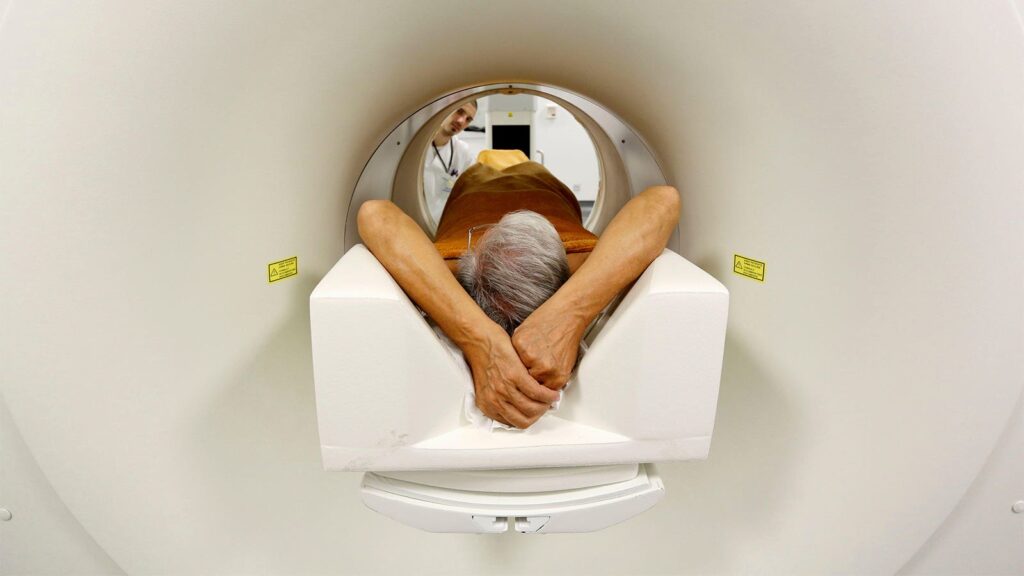Prostate-specific membrane antigen (PSMA)-PET/CT imaging identified metastatic prostate cancer in almost half of high-risk cases missed by conventional imaging, a retrospective analysis showed.
Overall, PSMA-PET/CT detected distant metastasis in 84 of 182 cases (46%) that were negative by other types of imaging, including polymetastatic disease (≥5 lesions) in a quarter of patients. PSMA-PET/CT identified metastatic disease in more than half of patients treated with definitive radiotherapy (RT) or by radical prostatectomy and salvage RT.
The findings suggest that patients with high-risk, nonmetastatic, hormone-sensitive prostate cancer (nmHSPC) are frequently understaged by conventional imaging and challenge interpretation of trial results that have relied on conventional imaging, reported Jeremie Calais, MD, PhD, of UCLA Health in Los Angeles, and co-authors in JAMA Network Open.
“PSMA-PET/CT continues to evolve as the most accurate imaging method for staging prostate cancer. Our results underline this is valid also for the hormone-sensitive disease stage,” co-author Adrien Holzgreve, MD, also of UCLA Health, told MedPage Today. “While the study design and previous evidence do not allow us to consider the findings as practice-changing, they strongly support that PSMA-PET is more sensitive for localizing anatomical sites of biochemical recurrence compared to conventional imaging alone.”
“Overall, we need more outcome-validated data to prove a clinical benefit of using PSMA-PET, for example, using survival data,” he added. “Yet, our findings illustrate there is a strong rationale for the use of PSMA-PET/CT imaging at biochemical recurrence in patients with high-risk hormone-sensitive prostate cancer.”
Proving a clinical benefit with use of PSMA-PET/CT is difficult at this point in the absence of high-quality data.
“Probably, a high percentage of patients with strong suspicion for a recurrence would benefit from PSMA-PET/CT when conventional imaging shows no evidence of metastatic spread,” said Calais. The study encompassed cancers with increased risk of metastatic disease and with an increased risk for shorter survival, and “it may make sense to first focus on these patients with high-risk features, as defined by serum tumor marker levels and histopathological features, for example, as they have a higher clinical need for imaging-based treatment decisions.”
In the prostate cancer setting of biochemical recurrence after definitive primary therapy, androgen receptor pathway inhibitors (ARPIs) have demonstrated clinical benefit in both metastatic disease and in patients with no prior exposure to chemotherapy, the authors noted in their introduction to the study. The phase III EMBARK trial showed that patients treated with single-agent enzalutamide (Xtandi) or the ARPI plus androgen deprivation therapy (ADT) had significant improvement in metastasis-free survival as compared with ADT plus placebo.
Enrollment in EMBARK was based on negative results with conventional imaging, which underdetects metastatic disease as compared with PSMA-PET/CT.
For their analysis, Calais and colleagues retrospectively analyzed PSMA-PET/CT findings in patients from four prospective studies who met inclusion criteria for the EMBARK trial: increasing PSA level >1.0 ng/mL after radical prostatectomy and salvage radiotherapy or 2.0 ng/mL above the nadir value after definitive radiotherapy, PSA doubling time ≤9 months, and serum testosterone ≥150 ng/mL.
Additionally, EMBARK excluded patients with distant metastatic disease (M1) detected by any conventional imaging, prior hormonal therapy (neoadjuvant or adjuvant) for >36 months at the time of definitive RT, more than 6 months of short-course ADT with less than 9 months of washout before randomization, or advanced systemic therapy for prostate cancer.
Data analysis included 182 patients who had a median pre-scan PSA level of 2.6 ng/mL Overall, 84% of the patients had positive PSMA-PET/CT results, including 80% (73 of 91) after radical prostatectomy, 92% (36 of 39) after definitive RT, and 85% (44 of 52) after radical prostatectomy and salvage RT. PSMA-PET/CT detected distant metastatic disease in 46% (84 of 182) of the patients, including 34% after radical prostatectomy, 56% after definitive RT, and 85% after radical prostatectomy and salvage RT.
PSMA-PET/CT detected polymetastatic disease in 24% (43 of 182) of patients, including 19% after radical prostatectomy, 36% after definitive RT, and 23% after prostatectomy and salvage RT.
PSMA-PET/CT has been evaluated more extensively in castration-resistant prostate cancer (CRPC). Although results from the current analysis cannot be directly extrapolated to the nonmetastatic CRPC setting, published data support use of PSMA-PET/CT in selected patients with nmCRPC.
“Our conclusions are sound for both disease stages and underline the high value and potential broad applicability of PSMA-PET/CT,” said Calais.
Holzgreve said more studies are needed to refine patient selection criteria for PSMA-PET/CT and to demonstrate a clinical benefit.
“This will also help to assess the cost-effectiveness of PSMA-PET/CT and to further facilitate its implementation in clinical guidelines and routine practice,” he said. “We currently assess the long-term follow-up data for the patient cohort that we analyzed in this study. Several efforts are made in our and other institutions to corroborate the prognostic value of PSMA-PET.”
“We are part of a large international consortium investigating the prognostic impact of PSMA-PET in comparison to established clinical prognosticators,” Holzgreve continued. “So far, more than 6,000 patients have been included. The analysis suggests that PSMA-PET outperforms established clinical prognosticators.”
Disclosures
Researchers were supported by the Deutsche Forschungsgemeinschaft, the UCLA-Caltech Medical Scientist Training Program, the Prostate Cancer Foundation, the NIH, the Society of Nuclear Medicine and Molecular Imaging, the Philippe Foundation, and the ARC Foundation.
Calais disclosed relationships with Amgen, Astellas, Bayer, Blue Earth Diagnostics, Curium Pharma, Coretag, DS Pharma, FibroGen, GE Healthcare, Isoray, IBA Radiopharma, Janssen Pharmaceuticals, Lantheus, Progenics, EXINI, Monrol, Novartis, Advanced Accelerator Applications, Nucleus Radiopharma, Pfizer, POINT Biopharma, RadioMedix, Radiopharm Theranostics, Siemens, SOFIE, Telix, and Progenics.
Holzgreve disclosed a relationship with ABX. Other co-authors disclosed relationships with industry and nonprofit groups.
Primary Source
JAMA Network Open
Source Reference: Holzgreve A, et al “PSMA-PET/CT findings in patients with high-risk biochemically recurrent prostate cancer with no metastatic disease by conventional imaging” JAMA Netw Open 2025; DOI: 10.1001/jamanetworkopen.2024.52971.
Please enable JavaScript to view the comments powered by Disqus.
Source link : https://www.medpagetoday.com/hematologyoncology/prostatecancer/113658
Author :
Publish date : 2025-01-06 19:47:05
Copyright for syndicated content belongs to the linked Source.
